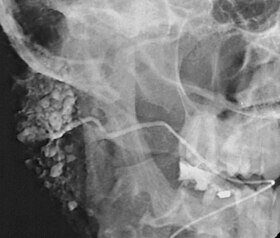Sialography
| Sialography | |
|---|---|

Sialogram in a patient suspected of Sjögren's syndrome
|
|
| MeSH | D012796 |
| MedlinePlus | 003812 |
Sialography (also termed radiosialography) is the radiographic examination of the salivary glands. It usually involves the injection of a small amount of contrast medium into the salivary duct of a single gland, followed by routine X-ray projections.
The resulting diagram is called a sialogram.
Indications include:
Contraindications include:
Contrast agents are classified into two groups: fat-soluble contrast agents and water-soluble contrast agents. Water-soluble contrast agents can fill the finer elements of the ductal system. Fat-soluble contrast agents are viscous and can cause allergic reactions. These can also cause discomfort to the patients. Fat-soluble contrast agents do not fill finer elements of the duct.
A baseline radiograph (scout film) of the required salivary gland would be taken, the duct is dilated using graded lacrimal probes, a cannula then is inserted in this salivary gland duct's opening in the mouth, then a Radio-opaque fluid (Contrast medium) is injected in the duct through a small tube.
A series of radiographs would then be taken to determine the flow of the fluid, identify any obstructions and its location, the rate of fluid excretion from the gland.
Usually the radiographs taken are lateral oblique views of the face as Orthopantomogram's are not useful for the purpose of locating the area due to superimpositions and the way they are taken to put the teeth in the main field.
This study is interpreted by evaluating the morphology of the salivary ducts for obstructions and chronic inflammation. Sialodochitis is a term describing dilation of the ducts caused by repeated inflammatory or infective processes. There is also irregular salivary duct stricture (narrowing) of the duct, which creates an appearance known as "sausage link" pattern on a sialogram. Suggestions of abscesses and autoimmune diseases such as Sjögren syndrome can also be elicited. Sialadenitis is inflammation of the salivary glands, which may cause acinar atrophy and create an appearance known as "pruning of the tree" on a sialogram, where there are less branches visible from the duct system. A space occupying lesion that occurs within or adjacent to a salivary gland can displace the normal anatomy of the gland. This may create an appearance known as "ball in hand" on an sialogram, where the ducts are curved around the mass of the lesion.
...
Wikipedia
